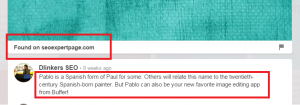Companies are always struggling to find new audiences, new customers, new distribution points for their messages and new ways of doing digital marketing. Right now, it’s all about digital content, whether it is long- or short-form, videos, images, webinars, white papers, or just the content on a site and/or blog. There is a lot of competition and clutter out there.
Every day I think about ways to enable a company and their content to rise above everyone else’s. There, unfortunately, is no magic bullet. But maybe there is a secret sauce…and perhaps “sauce” is a better term here. You need to blend it and craft your content using a mixture of ingredients, carefully mixed to produce the best results.
But every once in a while, there is a tool, or a movement, or a service that helps propel content ahead. Years ago, it was the invention of the blog. Suddenly, static, brochure-ware sites took on a new life, with (hopefully) regularly updated living content. And Google helped out…a lot…by favoring more regularly updated content over old and stale sites.
More recently, image and video sharing services like Instagram, Pinterest, SnapChat and Vine have captured marketers’ attentions, providing a means for consumers and companies to share rich content, their interests and their lives. So what is next? Digital marketers are trying to figure this out and be ahead of the curve.
I have an idea. I’m wondering if it is time to bring back the Webring.
Bring Back the Webring
What is a Webring? Well, and I’m dating myself here, back in the late 1990’s and early 2000’s, there was a movement that literally linked similar websites together. Typically these were not company sites but rather amateur sites which shared common interests. Like underwater basket weaving? Have your own site about it? Know of other similar sites and want to show a “solidarity” of sorts? You signed up to be part of the underwater basket weaving Webring. Once you were registered and part of the Webring, you had a shared navigation bar which allowed an end-user to click to see the “next” site within the specific Webring. And your site had a little badge for you to display.

The Webring created a sense of community. It offered people looking for a particular topic or interest to stay within a close group of similar content. It was providing curation, not of specific content, but of specific topics.
Then the Webring movement sort of faded away.
Modern Day Webring Equivalents
There are, obviously, modern day equivalents, but they aren’t quite Webrings.

You can hashtag similar content. That of a loose grouping of similar ideas…maybe…but without much control.
You can join affiliate networks to promote and sell something. But this is advertising. Anyone can be an affiliate. It’s only a “network” because you link your ad or banner to a site, product or service that you “believe” in.
You can join groups on Facebook, LinkedIn, Quora, or other social media communities. These are public or private, may or may not have the content curated in some way, and provide a sense of belonging via discussions.
You can categorize content for consumption with aggregators like FlipBoard. But anyone can post to these categories thus making them loose couplings.
Even a forum or bulletin board system, a more older form of digital community, isn’t quite like a Webring. You could even throw Reddit into the mix.

From what I can tell, there currently isn’t really something quite like the Webring was.
Introducing Webring 2.0
So maybe now is the time to reinvent and reintroduce the Webring. Here are some ideas I feel why Webring 2.0 might be successful.
- Community – For content to be successful, it cannot exist in a vacuum. It must be nurtured, shared and discussed. It must have a sense of community. If like-minded sites, businesses and people are linked together, this community exists. A Webring would provide this physical linkage.
- Purpose – Companies and individuals must have a sense of purpose – a reason for why they exists and why they work. When defining a Webring, you would have to adhere to this sense of purpose in order to join like-minded groups together.
- Relevance – For content and digital strategy to be successful, it must be relevant to the audience consuming it. Users are exposed to tens of thousands of message online and offline every day, perhaps even hundreds of thousands. A Webring would provide this relevance due to the grouping.
- Differentiation – In order to stand out above the crowd, a company and its content much be different. There are numerous ways to do this. If you are a first-mover in a space, whether it’s via a product or a way you craft your content strategy, you can get noticed. Could a Webring differentiate? Potentially.
Webring 2.0 would need to have many of the characteristics as the first iteration. You would have to have an administrator to allow (or kick out) other sites or communities. You would have to set up some type of branding. And you would have to figure out how to keep it alive.
But Webring 2.0 would have to be different.
Extending Webring 2.0
I recently read an article about how branded browser extensions may be the next digital marketing trend. They already exist. There is a ton of potential there.

What if there was a browser extension/toolbar created by a company or brand which utilized the Webring 2.0 concept? Assuming the Webring of a company or group was active, the extension could stay persistent to regularly remind a user of the group and the content therein. Perhaps if a member of the Webring posting some new content, the browser extension could notify the user and even allow for interaction and sharing of the content.
Or perhaps Webring 2.0 could include functionality similar to StumbleUpon, a site that lets you visit and rate, user-submitted digital content based on your preferences. If the Webring was large enough, you could regularly have your extended community seeing and hopefully interacting with this content.
Local brick and mortar or boutique businesses could link via a Webring to others in the locality to promote locally, or link on the web to similar businesses but in different geographic locations to promote the similar product or service.
Larger businesses could group their resellers, distributors or retailers within a Webring to both show solidarity but also promote their product or service without playing favorites. Instead of having just a page on the website devoted to this topic, the Webring could cycle a prospective client through different companies who sell or distribute the product.
You know that saying: what’s old is new again? Would it be too nostalgic to bring back the Webring? I believe under the right circumstances and with the right technology, a Webring could help companies build their communities, share content and branding wider to new audiences and differentiate themselves from the competition in an old…er…new way.
Digital & Social Articles on Business 2 Community(46)










